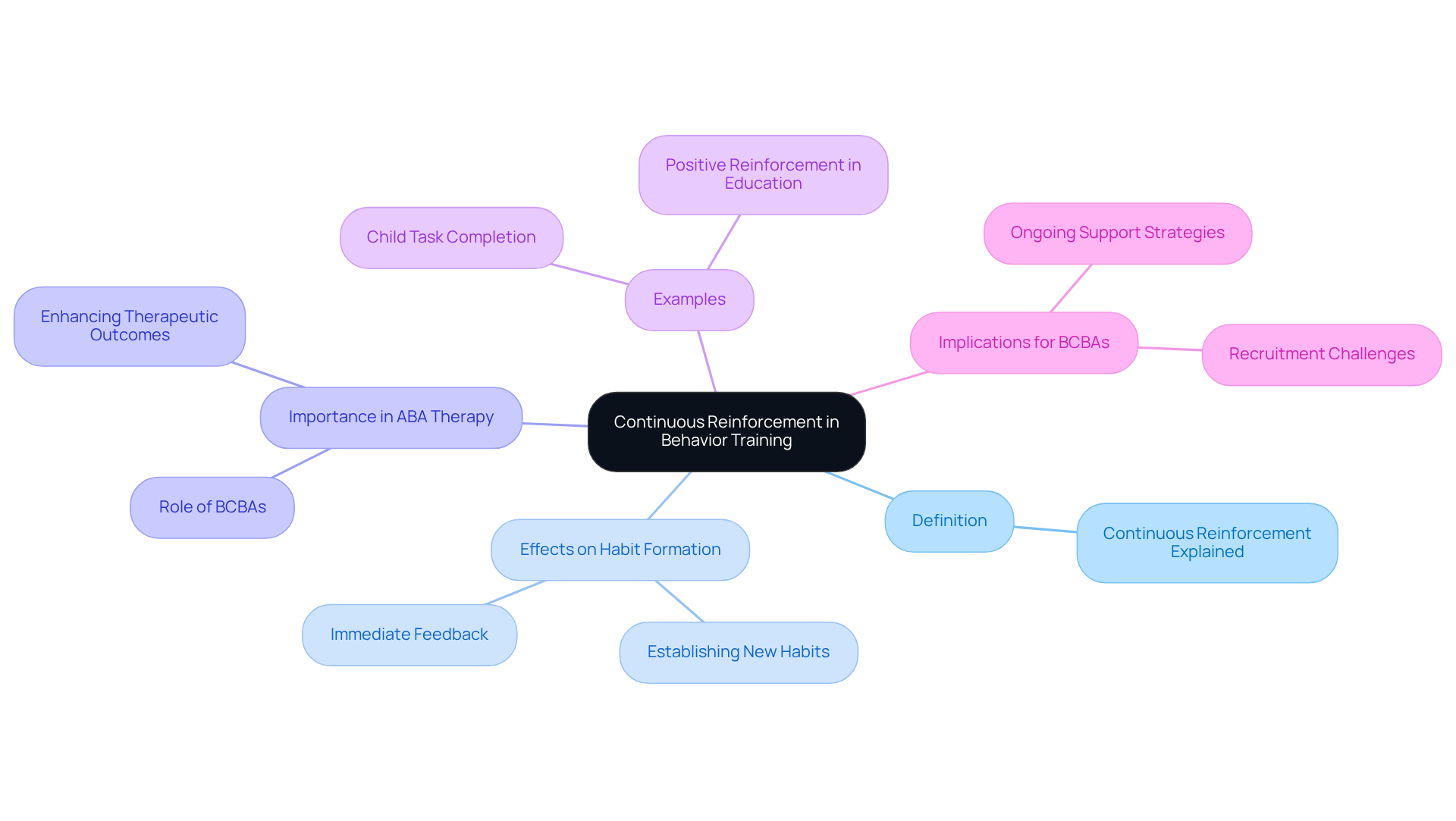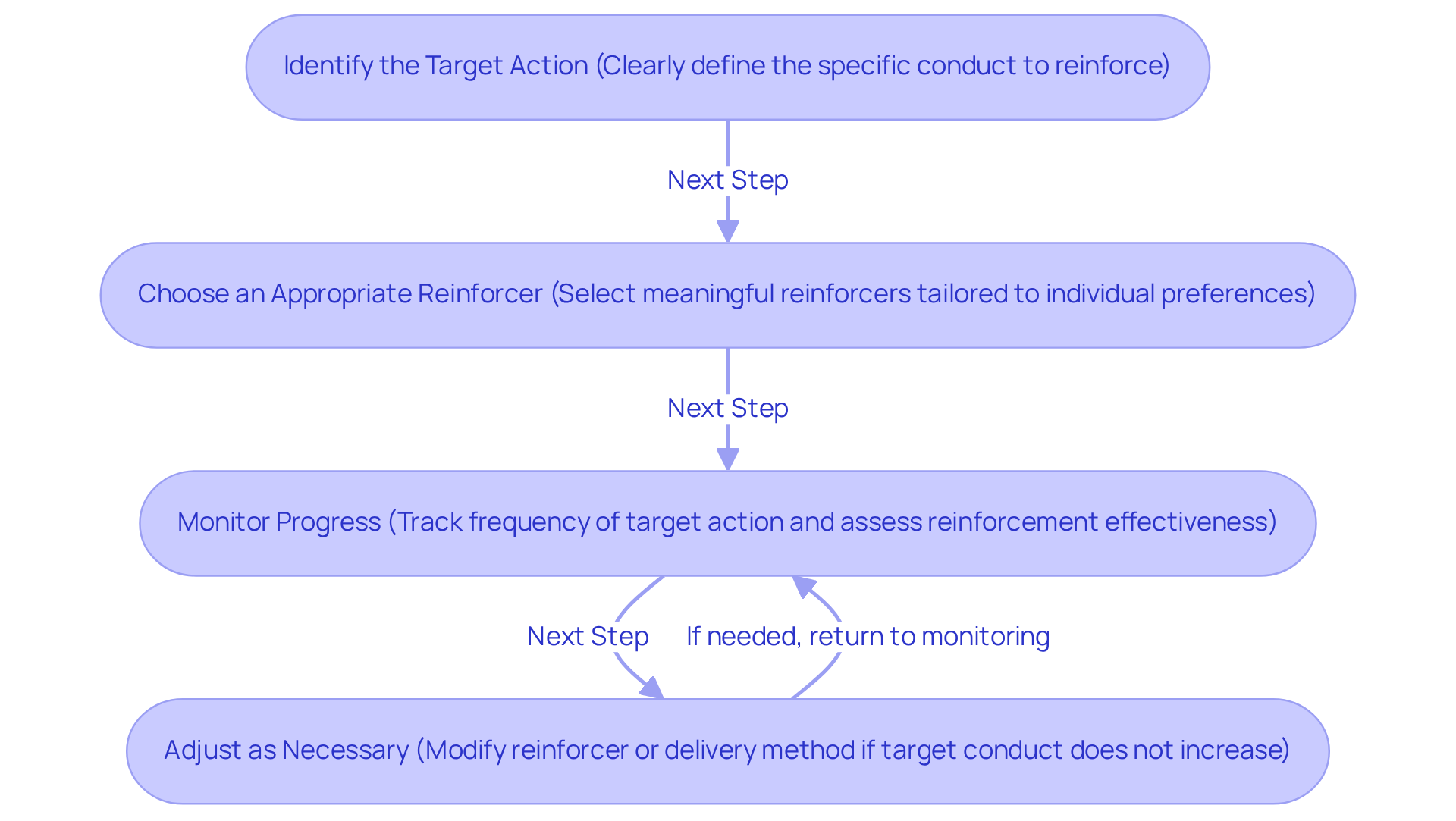October 21, 2025

This article delves into the effective implementation of continuous reinforcement in behavior training, outlining structured steps designed to enhance its application. It underscores the critical role of consistent reinforcement, the selection of appropriate reinforcers, and the necessity of monitoring progress. By addressing common challenges, it provides a comprehensive framework that empowers practitioners to significantly improve behavior modification outcomes.
The escalating demand for Board Certified Behavior Analysts (BCBAs) underscores a pressing need for effective behavioral training strategies, particularly the implementation of continuous reinforcement. This potent method not only fortifies the link between desired actions and rewards but also significantly increases the likelihood of behavior repetition, rendering it indispensable for professionals in the field. Yet, as practitioners endeavor to leverage the advantages of continuous reinforcement, they may face challenges that threaten their success.
What are the essential steps for effectively implementing this approach, and how can one adeptly navigate the common obstacles that may arise throughout the process?
The anticipated demand for Board Certified Behavior Analysts (BCBAs) is set to rise by 25% by 2026, underscoring the critical need for effective behavioral training strategies. Continuous reinforcement occurs when a desired action is reinforced each time it takes place in a behavioral training approach. This method is particularly effective for establishing new habits, providing immediate feedback to the individual. For instance, when a child is rewarded each time they complete a task, they are more likely to repeat that behavior. Understanding this principle is essential for professionals, as it lays the foundation for more complex support strategies in the future.
Continuous reinforcement occurs when ongoing support is employed in the initial stages of behavior change, strengthening the connection between the action and the reward, thereby increasing the likelihood of repetition. According to B.F. Skinner, the power of positive reinforcement is vital in education and behavior modification, as it encourages desirable actions. By consistently reinforcing these actions, practitioners can significantly improve the success rates of modification efforts, leading to more effective therapeutic outcomes.
As the demand for BCBAs continues to grow, it is imperative for healthcare employers to consider how platforms like Hire ABA can assist in addressing their recruitment challenges. Are you prepared to enhance your team's capabilities with qualified professionals? By leveraging ongoing support strategies, you can ensure a more effective approach to Applied Behavior Analysis (ABA) therapy, ultimately benefiting both practitioners and clients alike.

To effectively implement continuous reinforcement, follow these structured steps:
Identify the Target Action: Clearly define the specific conduct you wish to reinforce, such as completing homework or following instructions. This clarity is essential for effective intervention.
Choose an Appropriate Reinforcer: Select a reinforcer that holds significance for the individual. Effective options may include verbal praise, tokens, or tangible rewards, tailored to the individual's preferences and motivations. Research indicates that using meaningful reinforcers can significantly enhance engagement and participation in therapeutic settings.
Continuous reinforcement occurs when certain behaviors are rewarded consistently. Establish a reward schedule, as continuous reinforcement occurs when the desired action is acknowledged each time it occurs. This consistency is crucial in the initial phases of altering behaviors to reinforce the desired conduct. Ongoing support has been demonstrated to be especially effective in enhancing the occurrence of target actions in individuals with Autism Spectrum Disorder (ASD).
Monitor Progress: Regularly track the frequency of the target action and assess the effectiveness of the reinforcement. Utilize data collection techniques such as tally sheets or conduct charts to maintain an objective record of progress. Ongoing data collection is vital for monitoring improvements and making informed adjustments to intervention strategies.
Adjust as Necessary: If the target conduct does not increase as expected, be prepared to modify the reinforcer or its delivery method. Ensuring that the support remains encouraging is essential for maintaining change in actions. Ethical decision-making in ABA highlights the significance of modifying approaches to address the changing requirements of clients, ensuring that interventions stay effective and focused on the client.
By adhering to these steps, professionals can create a robust structure for applying ongoing support, ultimately improving the effectiveness of behavior modification strategies. Are you aware of the potential obstacles in the implementation process? Recognizing these challenges can equip professionals for real-world applications, enhancing their capacity to effect meaningful change.

Implementing continuous reinforcement occurs when practitioners navigate several challenges effectively.
Inconsistent support is a critical issue. It is vital to offer encouragement consistently every time the target action occurs. Inconsistency can lead to confusion, diminishing the effectiveness of the reinforcement and potentially resulting in a decline in the action. A study reported resurgence as high as 92% of applications during schedule thinning, underscoring the necessity of maintaining consistency.
Diminished motivation is another concern. Over time, the appeal of the reinforcer may wane, resulting in decreased motivation for the target behavior. Regular evaluations of the reinforcer's effectiveness are essential, and professionals must be prepared to adjust the reinforcer to sustain engagement. As B.F. Skinner noted, "Our behavior is influenced by our self-perception," emphasizing the need for practitioners to consider the motivational aspects of rewards.
Behavioral regression and resurgence can also occur. A decline in the target behavior following initial success may indicate insufficient support or environmental changes. Practitioners should reassess the reward schedule to ensure that individuals continue to receive appropriate incentives for desired behaviors. Understanding the phenomenon of resurgence, where previously reinforced actions reemerge when another action is placed on extinction, is crucial in this context.
Excessive dependence on reinforcement can hinder progress. While ongoing encouragement is effective for establishing new habits, transitioning to sporadic support is essential for long-term sustainability. Organizing this shift is vital to prevent reliance on continuous support, which may undermine the sustainability of the actions. The probabilistic delay-tolerance approach, which intermittently reinforces certain functional communication responses while applying extinction for others, can serve as a practical method for managing this transition.
By recognizing these common challenges and implementing strategies to address them, practitioners can significantly enhance the effectiveness of continuous reinforcement when they engage in their behavior training efforts.

Mastering continuous reinforcement is not just beneficial; it is essential for behavior training in today's rapidly evolving landscape. As the demand for qualified professionals in this field continues to rise, this approach lays the groundwork for effective behavior modification and significantly enhances the likelihood of desired actions being repeated. By understanding and implementing continuous reinforcement, practitioners can dramatically improve their therapeutic outcomes, ultimately providing superior support for their clients.
The article outlines critical steps for effectively implementing continuous reinforcement. These include:
Furthermore, it highlights common challenges such as:
It offers strategies to navigate these issues effectively. By adhering to these structured steps and being aware of potential obstacles, professionals can create a robust framework for behavior training that fosters lasting change.
Ultimately, the significance of continuous reinforcement extends beyond immediate behavior modification; it plays a vital role in shaping long-term habits and enhancing the overall effectiveness of Applied Behavior Analysis (ABA) therapy. Embracing these strategies not only benefits practitioners but also empowers individuals on their journey toward positive behavior change. This underscores the importance of ongoing support in the realm of behavioral training, inviting professionals to reflect on how they can further enhance their practice.
What is continuous reinforcement in behavior training?
Continuous reinforcement is a behavioral training approach where a desired action is reinforced each time it occurs, helping to establish new habits and providing immediate feedback.
How does continuous reinforcement affect behavior change?
It strengthens the connection between the action and the reward, increasing the likelihood of the behavior being repeated, especially during the initial stages of behavior change.
Why is continuous reinforcement important for professionals in the field?
Understanding continuous reinforcement is essential for professionals as it lays the foundation for more complex support strategies and improves the success rates of behavior modification efforts.
Who is B.F. Skinner and what is his contribution to behavior modification?
B.F. Skinner was a psychologist known for his work on positive reinforcement, which is vital in education and behavior modification, as it encourages desirable actions through consistent reinforcement.
What is the anticipated demand for Board Certified Behavior Analysts (BCBAs)?
The anticipated demand for BCBAs is set to rise by 25% by 2026, highlighting the need for effective behavioral training strategies.
How can platforms like Hire ABA assist healthcare employers?
Platforms like Hire ABA can help healthcare employers address recruitment challenges by providing access to qualified professionals, enhancing their team's capabilities in Applied Behavior Analysis (ABA) therapy.
Our expert recruitment strategies and AI-driven sourcing ensure that you receive top-notch candidates quickly, without compromising on quality. Whether you’re looking for BCBAs, Clinical Directors, or RBTs, we’ve got you covered.